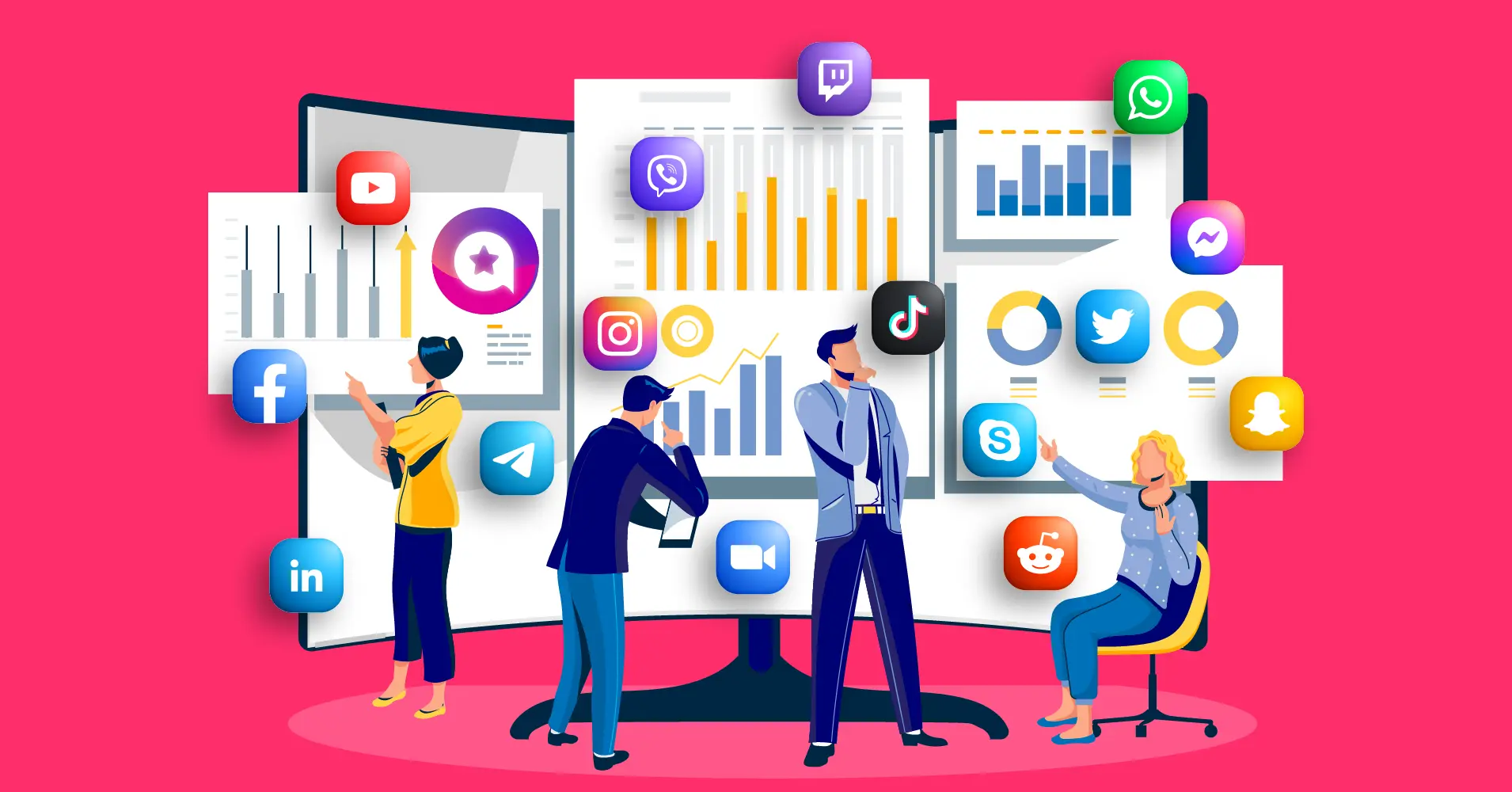In today’s highly competitive business landscape, effective branding is crucial for success. Whether you’re a small startup or an established corporation, having a strong brand identity can make all the difference. Fortunately, there are numerous branding tools available that can help you create, manage, and analyze your brand. From logo design tools to social media scheduling platforms, these tools can streamline your branding efforts and ensure consistency across all channels.
In this blog, we will explore the ultimate list of the best branding tools you can’t afford to miss.
Why is branding important in today’s competitive market?
In today’s fast-paced and highly competitive business landscape, branding plays a crucial role in the success of a company. It goes beyond just creating a catchy logo or tagline; it encompasses the overall identity and reputation of a brand in the market. Here are some reasons why branding is important in today’s competitive market:
Here are some reasons why branding is important in today’s competitive market:
1. Differentiation:
A strong brand helps businesses stand out from their competitors. With numerous options available to consumers, a well-established and recognizable brand becomes a deciding factor in their purchase decisions. A unique brand identity sets a business apart from the competition and makes it memorable.
2. Trust and Credibility:
Building trust and credibility is essential for attracting and retaining customers. A strong brand image instills confidence in consumers, assuring them of the quality and reliability of products or services. Customers are more likely to choose a brand they trust and have positive experiences with.
3. Customer Loyalty:
A strong brand establishes a loyal customer base. When customers identify with a brand and its values, they become brand advocates, spreading positive word-of-mouth and referring others to the business. Building loyalty leads to repeat purchases, increased customer lifetime value, and ultimately, long-term business growth.
4. Consistency:
Effective branding ensures consistency across all marketing channels and touchpoints. This consistency in messaging, visuals, and customer experience creates a unified brand identity and reinforces brand recall. Consistency builds trust and fosters customer engagement and loyalty.
5. Brand Recognition:
A well-crafted brand identity helps businesses break through the clutter and attract attention in a crowded marketplace. Consistent branding elements such as logos, colors, and typography make a brand easily recognizable and memorable. This recognition leads to increased brand recall and familiarity among consumers.
6. Value Perception:
Strong branding can create a perception of higher value and quality in the minds of consumers. When a brand consistently delivers on its promises and maintains a positive reputation, customers are willing to pay a premium for its offerings. This perceived value gives businesses a competitive edge and allows them to command higher prices.
In conclusion, branding is of utmost importance in today’s competitive market. It not only helps businesses differentiate themselves from the competition but also builds trust, fosters customer loyalty, and creates a strong brand identity. By investing in effective branding strategies and utilizing the right branding tools, businesses can position themselves for success and achieve their marketing goals.
Identify your branding needs
Before diving into the world of branding tools, it is important to first identify your specific branding needs. Every business is unique, and it is crucial to understand what you want to achieve through your branding efforts. Here are some steps to help you identify your branding needs:
Here are some steps to help you identify your branding needs:
1. Clarify your business goals:
Start by defining your long-term and short-term business goals. What do you want to accomplish? Are you looking to increase brand awareness, attract new customers, or establish yourself as an industry leader? Understanding your overall business objectives will help you determine the role that branding will play in achieving these goals.
2. Know your target audience:
Identifying your target audience is essential for effective branding. Who are your ideal customers? What are their needs, preferences, and pain points? Conduct market research and gather data to gain a clear understanding of your target audience’s demographics, psychographics, and behavior. This information will guide your branding efforts and help you create a brand that resonates with your intended audience.
3. Evaluate your current brand perception:
Take a close look at your current brand image and reputation. How is your brand currently perceived by your target audience and the general public? Assess your brand’s strengths, weaknesses, opportunities, and threats. This evaluation will give you insights into areas where your brand may need improvement or repositioning.
4. Define your brand personality and values:
Your brand personality is the emotional and human characteristics that you want your brand to embody. Are you aiming for a fun and energetic brand, or do you want to portray a more professional and sophisticated image? Define the values that your brand stands for, such as quality, innovation, sustainability, or customer-centricity. Having a clear brand personality and values will guide your branding decisions and help you create a consistent brand experience.
5. Analyze your competition:
Research and analyze your competitors’ branding strategies. How do they position themselves in the market? What are their unique selling points? Understanding your competition will help you identify gaps in the market that you can leverage through your branding efforts. It will also ensure that your brand stands out and offers something distinct to your target audience.
6. Consider future growth and scalability:
As you plan your branding strategy, consider your future growth and scalability. Will your brand be able to adapt and evolve as your business expands? Anticipating future changes and incorporating flexibility into your brand strategy will save you from rebranding efforts down the line.
By following these steps, you will be able to identify your specific branding needs and lay the foundation for a successful branding strategy. Once you have a clear understanding of your needs, you can then explore the best branding tools to help you achieve your goals.
Top branding tools for creating a strong visual identity
Creating a strong visual identity is crucial for effective branding. Visual elements such as logos, colors, typography, and imagery play a significant role in conveying your brand’s personality and values. To help you create an impactful visual identity, here are some top branding tools that you can’t afford to miss:
To help you create an impactful visual identity, here are some top branding tools that you can’t afford to miss:
1. Canva:
Canva is a user-friendly graphic design platform that offers a wide range of templates, stock images, fonts, and graphic elements. It allows you to easily create stunning visuals for your brand, such as logos, social media posts, banners, and presentations. Canva’s drag-and-drop interface makes it accessible to users with no design experience.
2. Adobe Creative Cloud:
Adobe Creative Cloud is a comprehensive suite of professional design tools, including Photoshop, Illustrator, and InDesign. These tools offer advanced features and capabilities for creating custom designs and visual assets. With Adobe Creative Cloud, you can design logos, edit images, create marketing materials, and more.
3. Piktochart:
Piktochart is a web-based tool that specializes in creating infographics, presentations, and reports. It provides a range of customizable templates and design elements to help you visualize data and communicate information effectively. Piktochart is known for its intuitive interface and user-friendly drag-and-drop editor.
4. Brandmark:
Brandmark is an AI-powered logo maker that uses machine learning algorithms to generate unique logo designs based on your industry and preferences. It offers a quick and cost-effective solution for startups and small businesses looking to create a professional logo. Brandmark provides various customization options, allowing you to tailor the generated logo to your brand’s identity.
5. Coolors:
Coolors is a color palette generator that helps you choose harmonious and visually appealing color schemes for your brand. You can either generate random color palettes or manually input specific colors to create combinations. Coolors also offers integration with popular design tools and allows you to export color codes for seamless implementation.
6. Unsplash:
Unsplash is a go-to resource for high-quality, royalty-free images. It offers a vast collection of visually stunning photographs that can enhance your brand’s visual identity. You can search for specific themes or keywords to find images that align with your brand’s style and messaging.
7. Google Fonts:
Google Fonts provides a vast library of free, web-safe fonts that you can use to enhance your brand’s typography. With a wide range of typefaces to choose from, you can find fonts that convey the right tone and personality for your brand.
By leveraging these top branding tools, you can create a visually compelling and cohesive brand identity that resonates with your target audience. Remember to consider your brand’s personality, values, and target audience when selecting and customizing visual elements to ensure they align with your overall branding strategy.
Read Also:
- LinkedIn Banner Size Optimization for Maximum Impact
- Discover the Essence of Captivating Instagram Bio Quotes
- Ultimate Guide: Unlock YouTube Success with Tag Generation
- The Ultimate Guide to Generating Acronyms
Tools to enhance your brand messaging and storytelling
Branding is not just about visual elements; it also involves creating a strong brand message and engaging storytelling.  To enhance your brand’s messaging and storytelling, here are some tools you can’t afford to miss:
To enhance your brand’s messaging and storytelling, here are some tools you can’t afford to miss:
1. StoryChief:
StoryChief is a content marketing platform that allows you to streamline your content creation process. It provides a collaborative workspace for your team to plan, create, and distribute content across various channels. With StoryChief, you can ensure consistency in your brand messaging and storytelling by centralizing your content creation and approval process.
2. Grammarly:
Grammarly is a widely used writing assistant that helps you improve your writing by checking for grammar, spelling, and punctuation errors. It also provides suggestions for enhancing your writing style and clarity. By using Grammarly, you can ensure that your brand messaging and storytelling are error-free and effectively convey your message to your audience.
3. SEMrush:
SEMrush is a comprehensive SEO and digital marketing tool that can help you optimize your brand messaging and storytelling for search engines. It provides insights into keyword research, competitor analysis, and content optimization. By leveraging SEMrush, you can ensure that your brand messaging and storytelling are optimized for maximum visibility and reach.
4. Snappa:
Snappa is a graphic design tool that allows you to create stunning visuals for your brand’s messaging and storytelling. It offers a wide range of templates, stock photos, and graphic elements that you can customize to align with your brand’s style and message. Snappa’s user-friendly interface makes it accessible to users with no design experience.
5. Loom:
Loom is a video messaging tool that allows you to create and share personalized videos with your audience. It can be used to enhance your brand messaging and storytelling by adding a personal touch and humanizing your communication. Loom’s screen recording and webcam features enable you to showcase your products or explain complex concepts effectively.
By utilizing these tools to enhance your brand messaging and storytelling, you can create a compelling narrative that resonates with your audience and builds a strong emotional connection with your brand. Remember to stay true to your brand’s values and target audience when crafting your messaging and storytelling strategy.
Social media management tools for building and maintaining your brand presence
Social media has become an integral part of every business’s branding strategy. It allows brands to connect with their audience, showcase their products or services, and build a strong online presence. However, managing multiple social media platforms can be overwhelming and time-consuming. That’s where social media management tools come in. These tools help streamline the process of creating, scheduling and analyzing social media content. Here are some essential social media management tools for building and maintaining your brand presence:
1. ViralDashboard:
ViralDashboard is an advanced AI-powered social media management tool designed to streamline and enhance your online presence. With an array of features tailored to meet your social media needs, ViralDashboard simplifies content scheduling, engagement analysis, trend monitoring, influencer collaboration, and more. Whether you’re a business owner, marketer, or content creator, ViralDashboard equips you with the tools to optimize your social media strategy, boost engagement, and achieve your goals with ease.

2. Hootsuite:
Hootsuite is a popular social media management platform that allows you to manage all your social media accounts in one place. It provides features like content scheduling, audience engagement, and social media analytics. With Hootsuite, you can schedule posts in advance, monitor your brand mentions, and analyze the performance of your social media campaigns.
3. Buffer:
Buffer is a user-friendly social media management tool that enables you to schedule and publish content across multiple social media platforms. It offers a simple and intuitive interface, making it easy to manage your social media presence. Buffer also provides analytics to track the engagement and performance of your posts.
4. Sprout Social:
Sprout Social is a comprehensive social media management and analytics tool. It offers features like content scheduling, social media listening, and performance reporting. Sprout Social allows you to monitor conversations related to your brand, identify influencers, and measure the success of your social media efforts.
5. Later:
Later is a visual content marketing platform specializing in Instagram scheduling and management. It provides a user-friendly interface that allows you to plan and schedule your Instagram posts, stories, and carousel content. Later also offers features like visual content marketing calendars and analytics to track the engagement of your Instagram content.
6. Canva:
Canva is a graphic design platform that enables you to create visually appealing social media posts and graphics. It offers a wide range of templates, fonts, and graphic elements that can be customized to align with your brand’s visual identity. Canva’s drag-and-drop interface makes it easy for anyone to create professional-looking social media content.
By leveraging these social media management tools, you can save time, improve your workflow, and ensure consistent branding across your social media platforms. Remember to align your social media strategy with your overall brand messaging and storytelling to create a cohesive and impactful online presence.
Tracking and analytics tools to monitor your brand’s performance
Tracking and analyzing the performance of your brand is crucial to understanding its impact and success. By using tracking and analytics tools, you can gather valuable insights into your brand’s online presence and make informed decisions to optimize your strategies.![]() Here are some essential tracking and analytics tools that you can’t afford to miss:
Here are some essential tracking and analytics tools that you can’t afford to miss:
1. Google Analytics:
Google Analytics is a powerful tool that provides comprehensive data about your website’s performance. It tracks key metrics such as website traffic, user behavior, conversion rates, and more. With Google Analytics, you can gain insights into your audience demographics, engagement levels, and the effectiveness of your marketing campaigns.
2. Social media analytics tools:
Most social media platforms, such as Facebook, Twitter, and Instagram, offer built-in analytics tools that provide valuable data about your brand’s social media performance. These tools allow you to track metrics like audience engagement, reach, impressions, and follower growth. By analyzing these metrics, you can determine which social media strategies are most effective and make data-driven decisions to optimize your brand’s social media presence.
3. Brand monitoring tools:
Brand monitoring tools allow you to track mentions of your brand across various online channels, including social media, news websites, blogs, and forums. These tools provide real-time alerts whenever your brand is mentioned, allowing you to monitor your brand’s online reputation and respond to any mentions or discussions promptly. Some popular brand monitoring tools include Mention, Brand24, and Google Alerts.
4. Heatmap tools:
Heatmap tools, such as Crazy Egg or Hotjar, offer visual representations of user behavior on your website. These tools track where users click, scroll, and spend the most time on your website, providing insights into user engagement and preferences. Heatmap tools help you identify areas for improvement on your website and optimize the user experience to increase conversions and engagement.
5. Email marketing analytics tools:
If you use email marketing as part of your branding strategy, it’s crucial to track the performance of your email campaigns. Email marketing analytics tools, like Mailchimp or Constant Contact, allow you to track metrics such as open rates, click-through rates, and conversion rates. By analyzing these metrics, you can understand the effectiveness of your email campaigns and make improvements to optimize engagement and conversions.
By leveraging tracking and analytics tools, you can monitor your brand’s performance, understand your audience better, and make data-driven decisions to improve your branding strategies. Remember to regularly analyze the data provided by these tools and adjust your strategies accordingly to stay ahead in an increasingly competitive digital landscape.
Collaboration and project management tools for seamless brand management
Effective brand management requires seamless collaboration and efficient project management. To ensure your branding efforts run smoothly and efficiently, it’s essential to leverage the right collaboration and project management tools. These tools enable teams to stay organized, streamline communication, track progress, and ensure that everyone is aligned toward achieving brand objectives. Here are some collaboration and project management tools that can significantly enhance your brand management process:
Here are some collaboration and project management tools that can significantly enhance your brand management process:
1. Slack:
Slack is a popular communication and collaboration tool that allows team members to communicate in real-time through channels. It facilitates seamless communication, file sharing, and quick decision-making. With Slack, teams can easily collaborate, share updates, and discuss ideas, ensuring that everyone stays informed and engaged.
2. Trello:
Trello is a visual project management tool that uses boards, lists, and cards to help teams organize and track their work. It allows you to create tasks, assign them to team members, set due dates, and monitor progress. Trello provides a visual overview of the project’s status, enabling teams to prioritize tasks, collaborate effectively, and ensure timely completion.
3. Asana:
Asana is a versatile project management tool that enables teams to plan, organize, and track their work. It offers features such as task management, project timelines, calendar integration, and team collaboration. With Asana, you can assign tasks, set deadlines, track progress, and communicate with team members, ensuring that everyone is on the same page.
4. Basecamp:
Basecamp is a comprehensive project management platform that combines multiple tools into one cohesive platform. It offers features such as task management, file sharing, team messaging, and project scheduling. Basecamp simplifies project management by providing a centralized hub for all project-related activities, allowing teams to collaborate efficiently and stay organized.
5. Google Drive:
Google Drive is a cloud-based storage and collaboration platform that allows teams to create, store, and share files in real-time. It offers document editing, file sharing, and commenting features, enabling teams to collaborate seamlessly on branding materials such as brand guidelines, marketing collateral, and creative assets.
6. Monday.com:
Monday.com is an intuitive project management platform that offers customizable boards, timelines, and workflows. It helps teams plan, track, and collaborate on projects, ensuring that tasks are completed efficiently and on time. Monday.com provides a visual representation of project progress, allowing teams to identify bottlenecks and make informed decisions to keep the branding process on track.
7. Zoom:
Zoom is a video conferencing tool that facilitates virtual meetings and collaboration. It enables teams to connect and collaborate regardless of location, making it easier to discuss branding strategies, provide feedback, and conduct brainstorming sessions. Zoom also offers screen sharing and recording features, enhancing remote collaboration and ensuring that key brand discussions are captured.
By leveraging collaboration and project management tools, you can streamline brand management processes, enhance communication, and ensure that everyone is working towards the same brand vision. These tools facilitate seamless collaboration, improve productivity, and empower teams to deliver consistent and impactful branding strategies.
Wrapping up with a comprehensive list of essential branding tools
As we conclude our exploration of the best branding tools, it’s important to summarize the various tools and platforms that can elevate your brand management efforts. These tools play a crucial role in streamlining collaboration, enhancing communication, and ensuring the successful execution of your branding strategies. Here is a comprehensive list of essential branding tools you can’t afford to miss:
Here is a comprehensive list of essential branding tools you can’t afford to miss:
1. Slack:
This popular communication and collaboration tool enables real-time communication, file sharing, and quick decision-making, keeping your team informed and engaged.
2. Trello:
With its visual project management approach, Trello helps you organize and track your tasks, assign them to team members, set due dates, and monitor progress.
3. Asana:
This versatile project management tool allows you to plan, organize, and track your work, ensuring that everyone is on the same page and tasks are completed efficiently.
4. Basecamp:
Combining multiple project management features into one platform, Basecamp simplifies collaboration and provides a centralized hub for all project-related activities.
5. Google Drive:
This cloud-based storage and collaboration platform enables real-time document editing, file sharing, and commenting, making it easy to collaborate on branding materials.
6. Monday.com:
With its customizable boards, timelines, and workflows, Monday.com helps teams plan, track, and collaborate on projects effectively, ensuring tasks are completed on time.
7. Zoom:
This video conferencing tool facilitates virtual meetings and collaboration, allowing teams to connect and discuss branding strategies regardless of their location.
8. Canva:
Canva is a user-friendly graphic design tool that empowers you to create stunning visuals and branding materials even if you don’t have extensive design skills.
9. Hootsuite:
This social media management platform enables you to manage and schedule your social media content across various platforms, ensuring consistent and impactful brand messaging.
10. HubSpot:
With its comprehensive suite of marketing and sales tools, HubSpot helps you automate your marketing efforts, manage customer relationships, and track your brand’s performance.
11. SEMrush:
This all-in-one digital marketing platform provides tools for SEO, content marketing, social media management, and competitive analysis, helping you optimize your brand’s online presence.
12. SurveyMonkey:
Understanding your audience is essential for effective branding. SurveyMonkey allows you to create and distribute surveys to collect valuable feedback and insights from your target market.
By leveraging these essential branding tools, you can streamline your brand management processes, enhance communication, and deliver consistent and impactful branding strategies. Remember, each tool serves a specific purpose, so choose the ones that align with your brand’s goals and requirements. With the right tools in your arsenal, you can take your brand to new heights and stand out in the competitive market.
Conclusion
In conclusion, by staying ahead of the game with these essential branding tools, you can take your brand to new heights and differentiate yourself in the market. Embrace the power of technology and leverage these tools to enhance your brand’s communication, collaboration, and overall success.